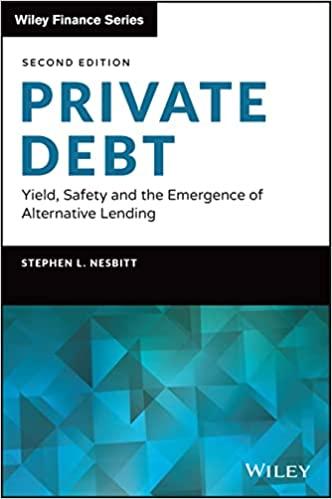Answered step by step
Verified Expert Solution
Question
1 Approved Answer
Problem 14-21 Yerba Industries is an all-equity firm whose stock has a beta of 1.2 and an expected return of 12.5%. Suppose it issues new
| Problem 14-21 | |||||||
| Yerba Industries is an all-equity firm whose stock has a beta of 1.2 and an expected return of 12.5%. Suppose it issues new risk-free debt with a 5% yield and repurchases 40% of its stock. Assume perfect capital markets. | |||||||
| a. | What is the beta of Yerba stock after this transaction? | ||||||
| b. | What is the expected return of Yerba stock after this transaction? | ||||||
| Suppose that prior to this transaction, Yerba expected earnings per share this coming year of $1.50, with a forward P/E ratio (that is, the share price divided by the expected earnings for the coming year) of 14. | |||||||
| c. | What is Yerbas expected earnings per share after this transaction? Does this change benefit shareholders? Explain. | ||||||
| d. | What is Yerbas forward P/E ratio after this transaction? Does the P/E ratio go up or down? | ||||||
| Unlevered beta | 1.20 | ||||||
| Expected return | 12.50% | ||||||
| Risk-free rate | 5.00% | ||||||
| New debt level | 40.00% | ||||||
| New Debt/Equity | |||||||
| Market risk premium | |||||||
| a. | What is the beta of Yerba stock after this transaction? | ||||||
| New beta | |||||||
| b. | What is the expected return of Yerba stock after this transaction? | ||||||
| New expected return on equity | |||||||
| Suppose that prior to this transaction, Yerba expected earnings per share this coming year of $1.50, with a forward P/E ratio (that is, the share price divided by the expected earnings for the coming year) of 14. | |||||||
| c. | What is Yerbas expected earnings per share after this transaction? Does this change benefit shareholders? Explain. | ||||||
| Old EPS | $1.50 | ||||||
| Forward P/E | 14 | ||||||
| Assumed shares | 100 | ||||||
| Price per share | |||||||
| Old equity | |||||||
| New debt | |||||||
| New earnings | |||||||
| New equity | |||||||
| New shares | |||||||
| New EPS | |||||||
| d. | What is Yerbas forward P/E ratio after this transaction? Does the P/E ratio go up or down? | ||||||
| New P/E | |||||||
| Price/Earnings ratio | |||||||
| Requirements | |||||||
| 1. | In cell D16, by using cell references, calculate the new debt/equity ratio (1 pt.). | ||||||
| 2. | In cell D17, by using cell references, calculate the market risk premium (1 pt.). | ||||||
| 3. | In cell D21, by using cell references, calculate the new beta (1 pt.). | ||||||
| 4. | In cell D25, by using cell references, calculate the new expected return on equity (1 pt.). | ||||||
| 5. | In cell D34, by using cell references, calculate the price per share (1 pt.). | ||||||
| 6. | In cell D35, by using cell references, calculate the old equity (1 pt.). | ||||||
| 7. | In cell D36, by using cell references, calculate the new debt (1 pt.). | ||||||
| 8. | In cell D37, by using cell references, calculate the new earnings (1 pt.). | ||||||
| 9. | In cell D38, by using cell references, calculate the new equity (1 pt.). | ||||||
| 10. | In cell D39, by using cell references, calculate the new number of shares (1 pt.). | ||||||
| 11. | In cell D40, by using cell references, calculate the new earnings per share (1 pt.). | ||||||
| 12. | In cell D44, by using cell references, calculate the new price/earnings ratio (1 pt.). | ||||||
| 13. | To answer whether the price/earnings ratio rises or falls, you need to compare the new price/earnings ratio to the forward price/earnings ratio. In cell D45, type either Falls, Stays the same, or Rises (1 pt.). | ||||||
Step by Step Solution
There are 3 Steps involved in it
Step: 1

Get Instant Access to Expert-Tailored Solutions
See step-by-step solutions with expert insights and AI powered tools for academic success
Step: 2

Step: 3

Ace Your Homework with AI
Get the answers you need in no time with our AI-driven, step-by-step assistance
Get Started


